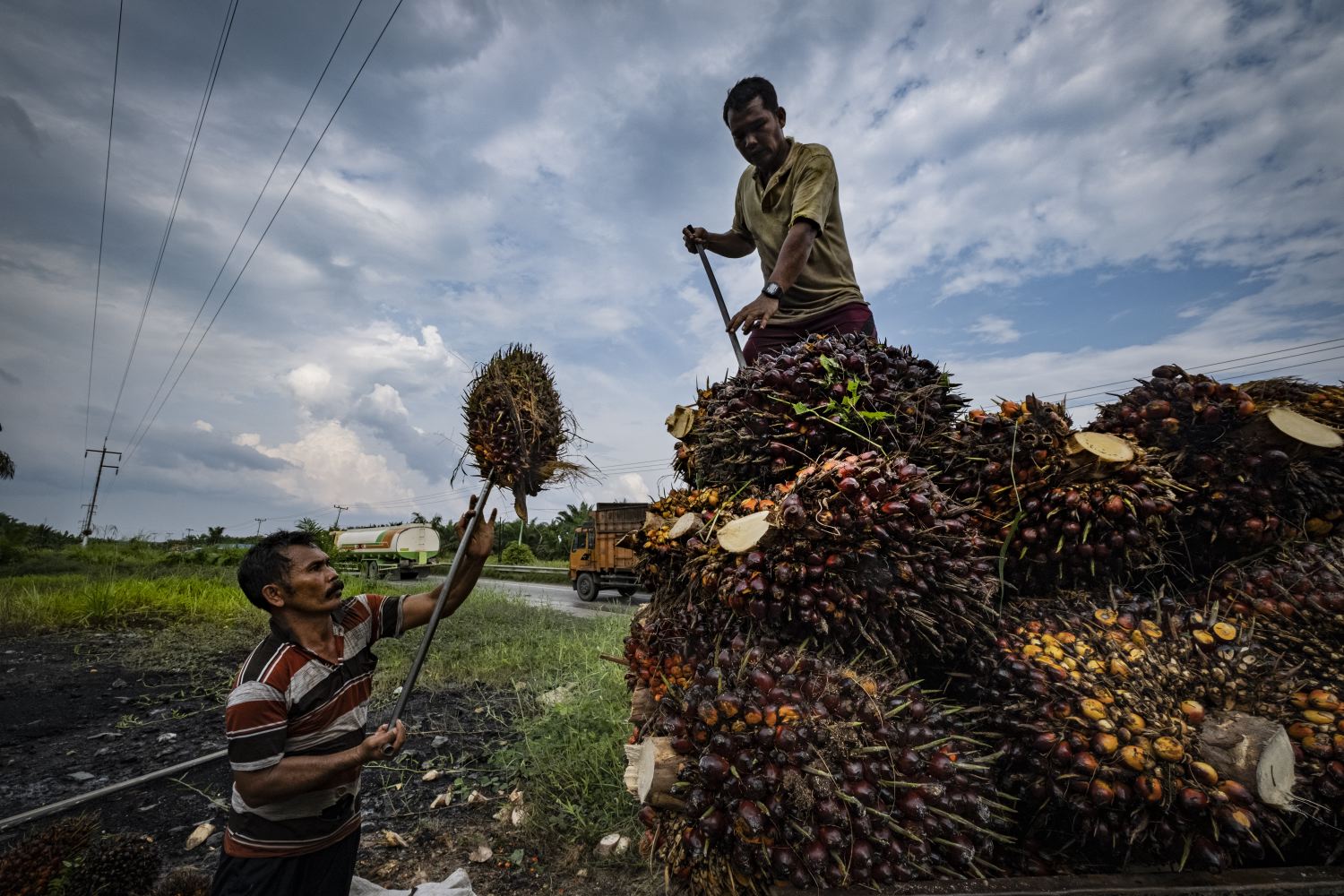 Two men load palm oil fruits onto a truck in Riau province, Sumatra.
Two men load palm oil fruits onto a truck in Riau province, Sumatra.
Industrial Palm Oil Deforestation in Indonesia Slows Slightly in 2024
 Two men load palm oil fruits onto a truck in Riau province, Sumatra.
Two men load palm oil fruits onto a truck in Riau province, Sumatra.
In 2024, the conversion of old-growth forests to industrial palm oil plantations in Indonesia slowed slightly compared to 2023 (White bars; Figure 1).
Our analysis, conducted using satellite images from Sentinel-2 and Planet/NICFI, reveals that industrial plantations expanded by 117,139 ha hectares in 2024 (White and black bars; Figure 1), a 9% decrease from the previous year. The associated deforestation also declined by 9%, with 31,314 hectares of forest converted in 2024 compared to 34,353 hectares cleared in 2023.
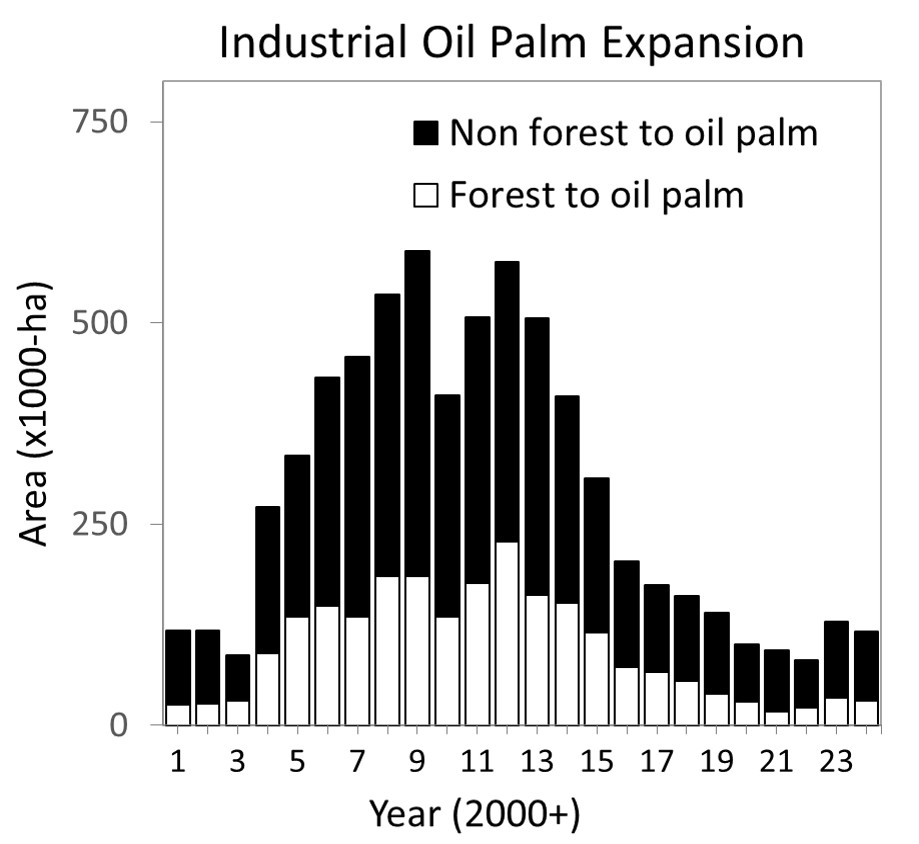
The conversion of peatlands for industrial palm oil cultivation also saw a 9% drop, with a total of 10,055 hectares cleared in 2024 compared to 11,245 hectares the previous year.
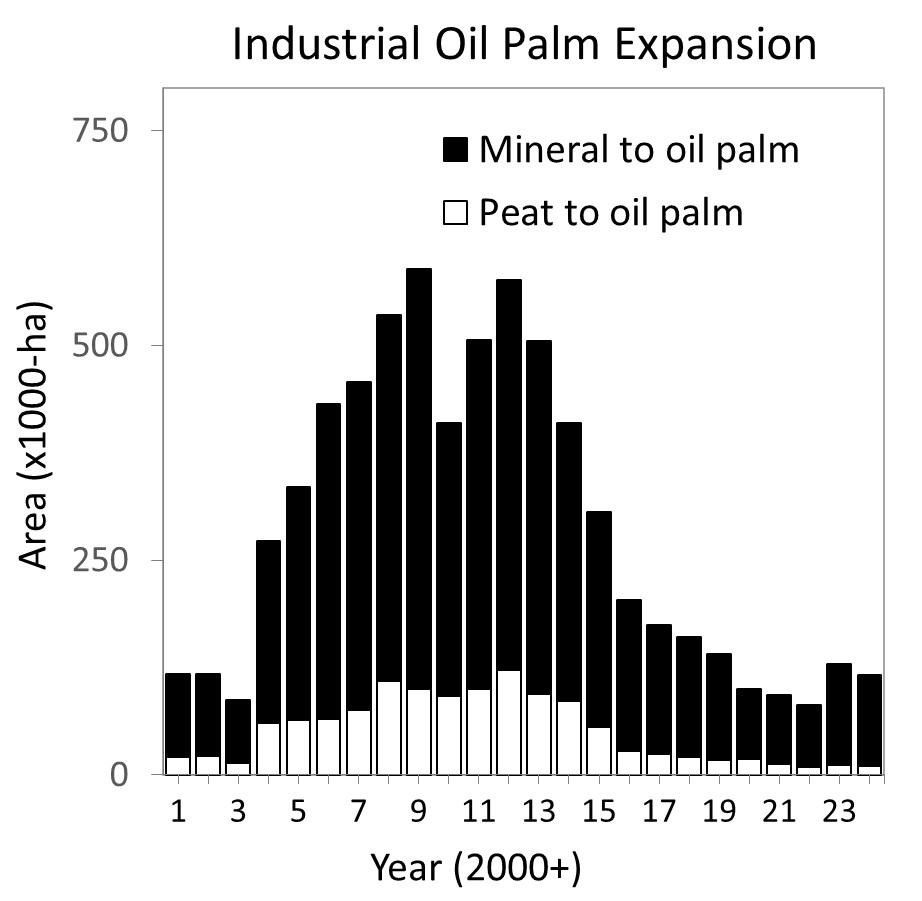
Regional analysis shows a decline in plantation expansion (light and dark bars) and associated deforestation (light bars; Figure 3) in Kalimantan and Sumatra. In contrast, both expansion and palm oil-driven deforestation increased in Papua and Sulawesi.
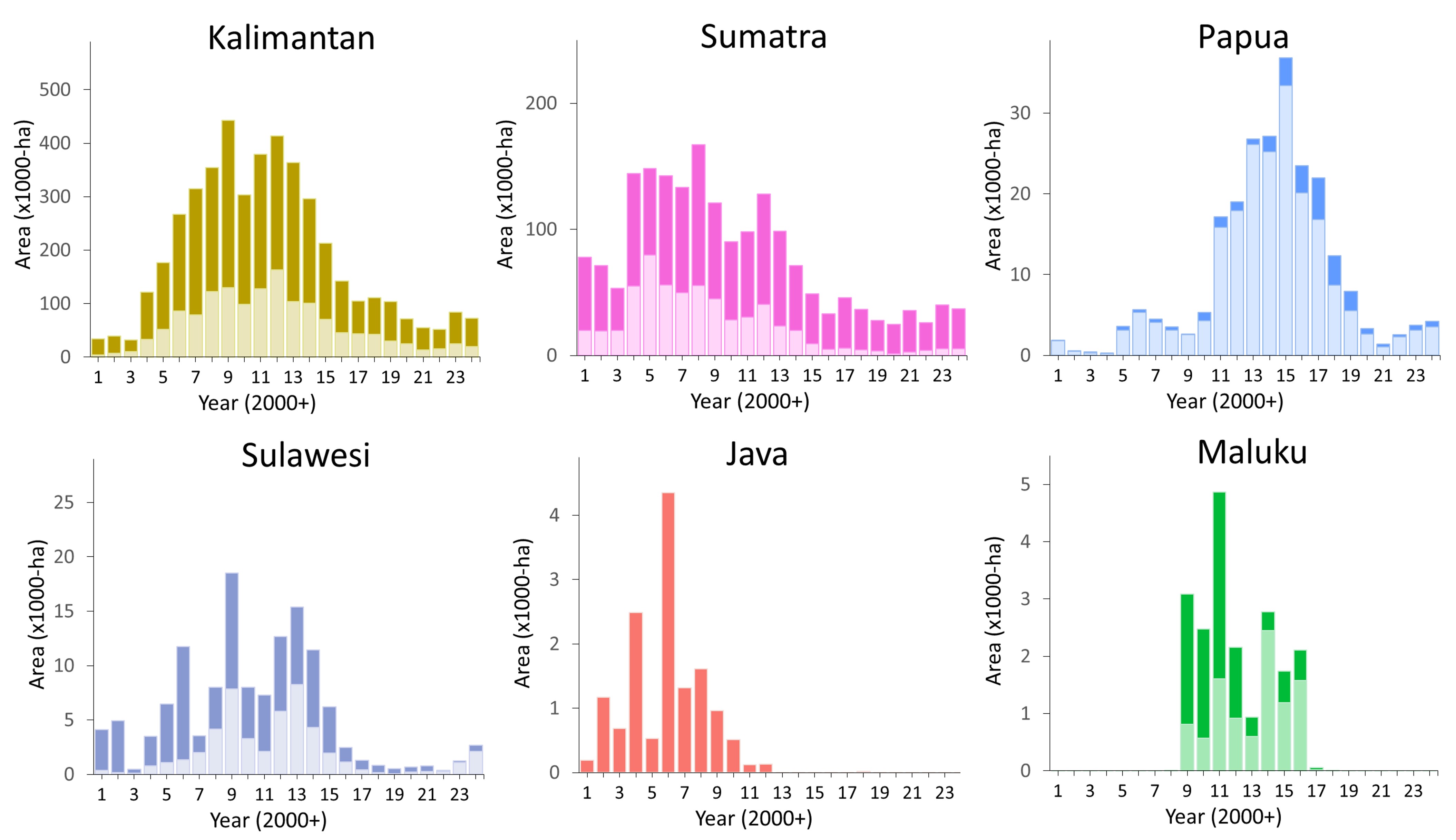
The Indonesian oil palm concession dataset, originally developed and published by Greenpeace and also maintained and updated in the Nusantara Atlas, exposes the companies still driving deforestation and peatland conversion for oil palm.
In 2024, 59 concessions cleared forest (>50 ha) to develop new oil palm plantations, and 21 exploited peatlands (see Table1&2).
For the second consecutive year, Ciliandry Anky Abadi led the pack in forest destruction, clearing 3,533 hectares in 2024 across three subsidiaries—two in West Papua and one in East Kalimantan. The largest share, 1,628 hectares, was cleared in the recently acquired Inti Kebun Sawit concession in Sorong regency; West Papua, which has held the notorious title of top deforester for oil palm for three years running. Meanwhile, Inti Kebun Sejahtera, also in Sorong, ranked fourth, and Tridaya Hutan Lestari, the third subsidiary, in East Kalimantan appears to have even cleared land beyond its concession boundaries.
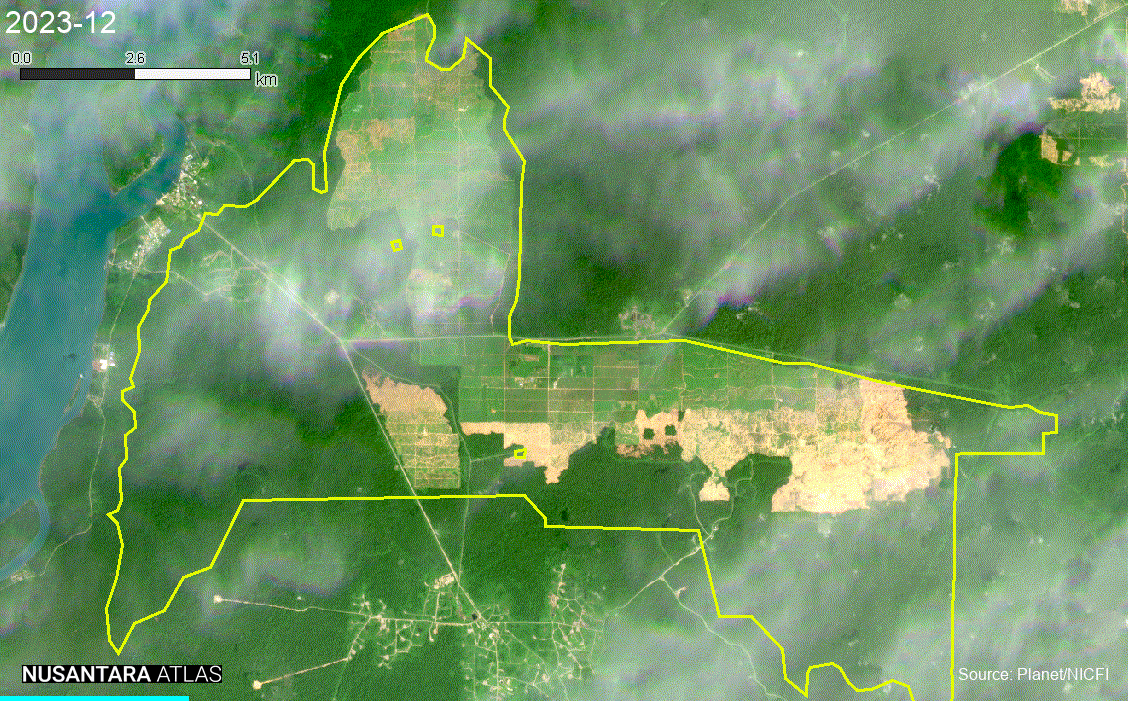
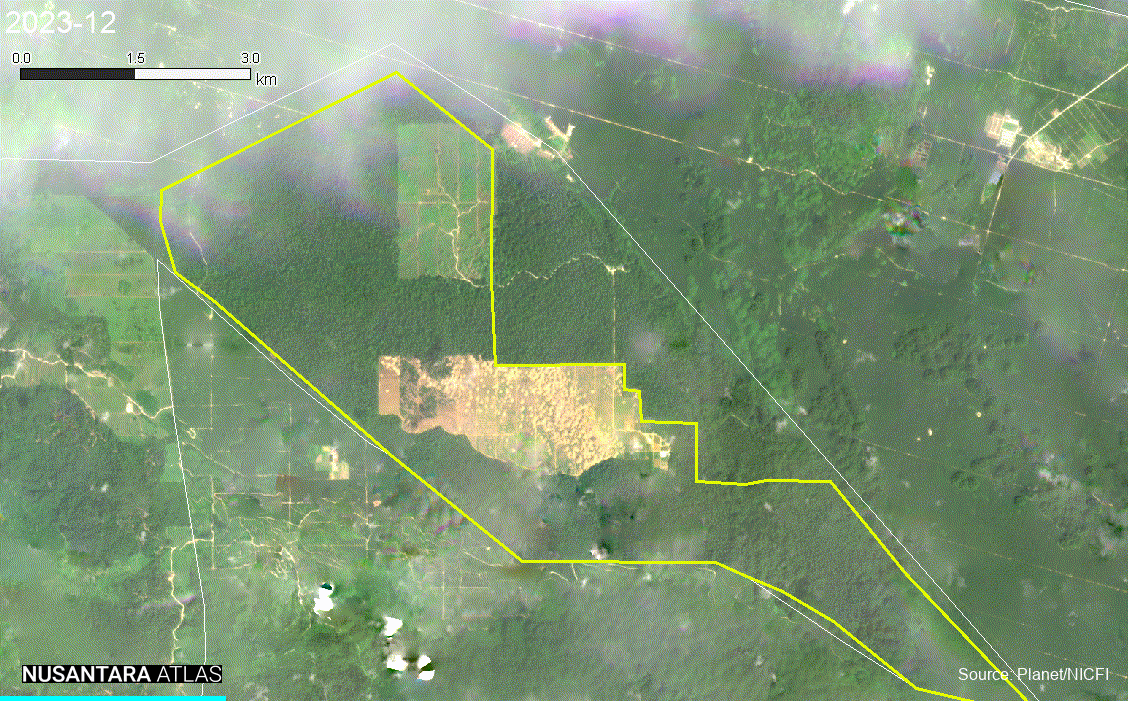
The “Chasing Shadows” article from The Gecko Project showed in 2023 that the Singapore-based company First Resources, a major palm oil producer known for marketing its product as ‘sustainable’ and RSPO-certified, is linked to Ciliandry Anky Abadi and Sulaidy, another forest destroyer. These companies were still implicated in the conversion of both forests and peatlands into industrial oil palm plantations in 2024.
Among other prominent contributors to forest destruction, Borneo International Anugerah stands out, having cleared 1,465 hectares of peat-swamp forest, also a prime habitat of Borneo orangutans. This company operates in the Kapuas Hulu Regency, West Kalimantan. It is owned by the First Borneo Group. Specifically, PT Borneo International Anugerah is 95% owned by PT First Borneo Plantations, which is 95% owned by Chancellor Oil Pte Ltd (Singapore), itself wholly owned by Premier Palmoil Energy Pte Ltd (Singapore).
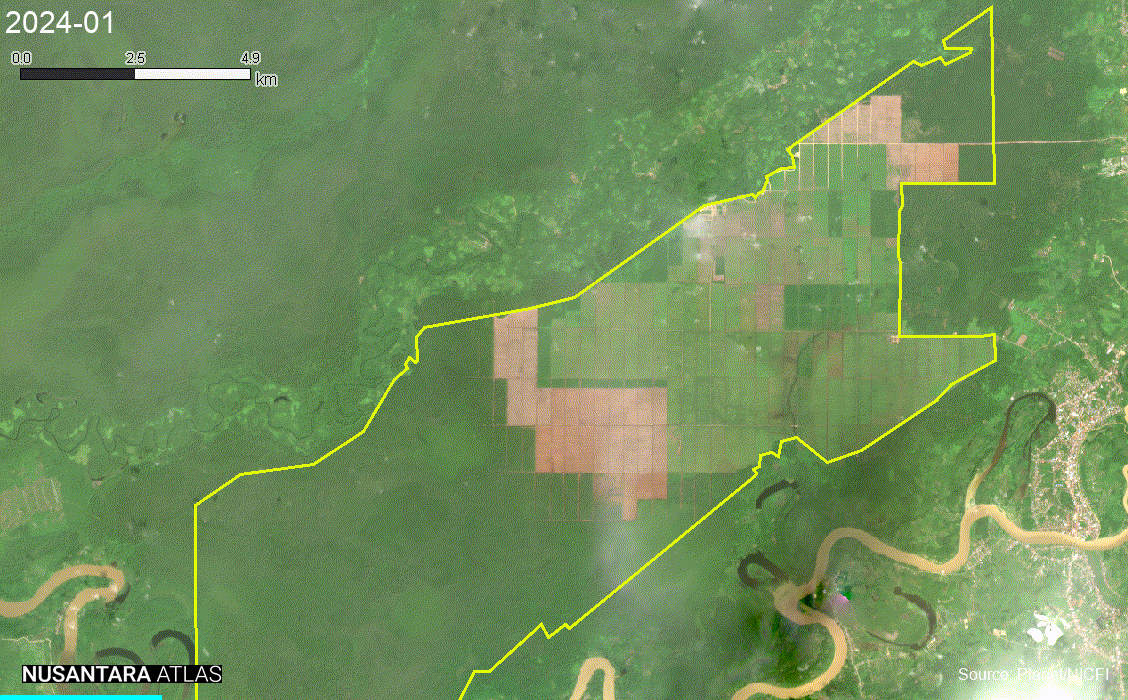
Banyan Tumbuh Lestari has been another significant contributor to forest destruction, having cleared 1,438 hectares of forest in 2014 deep in the interior of Gorontalo province, Sulawesi. However, it remains unclear whether all of this deforestation was intended for oil palm development, as the company has seemingly shifted its focus toward bioenergy production, particularly wood pellets. What was initially believed to be a new palm oil mill within the Banyan Tumbuh Lestari concession appears instead to be a timber processing facility, owned by a separate company, Biomass Jaya Abadi.
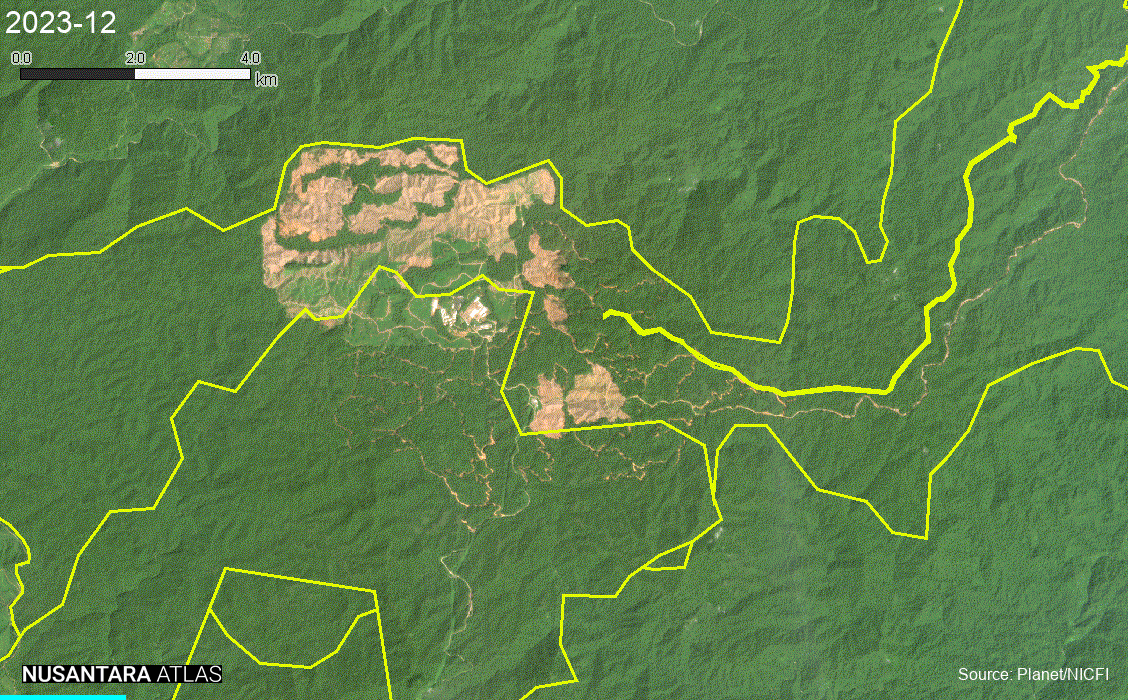
After nearly a decade of inactivity, Dongin Prabhawa—a Korindo-owned concession in Merauke Regency, Papua—abruptly resumed deforestation in 2024 to develop an oil palm plantation under a plasma scheme, as investigated by the local communities and Yayasan Pusaka Bentala (video below)
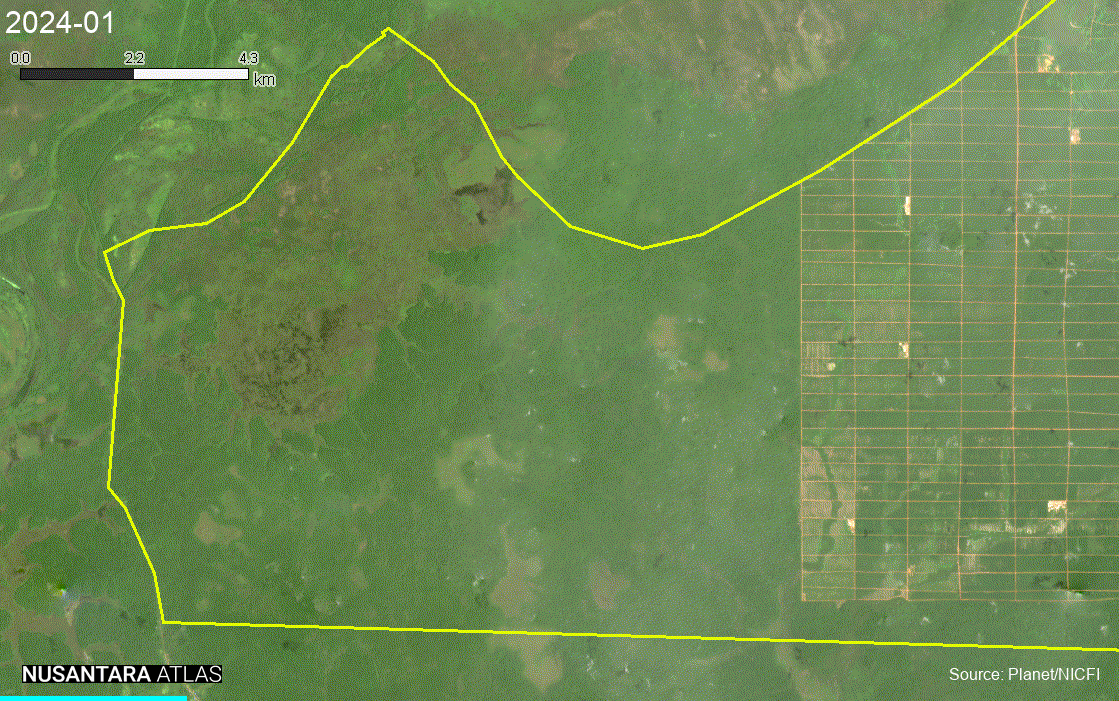
Credit: Katarina Yaas, local community and Yayasan Pusaka Bentala.
Compared to the recent deforestation analysis by Auriga Nusantara, our report shows less forest conversion to industrial oil palm due to a more conservative forest mask. For example, the Mitra Kapuas Agro concession ranks second in Auriga’s analysis with 1,534 hectares of forest loss, whereas our assessment records only 181 hectares of deforestation. While we also detect a significant expansion of 964 hectares within this concession in 2024, most of it is classified as non-primary forest in our database. Here, ‘Forest’ is old-growth, high carbon and high conservation value. It is equivalent to Hutan Primer and Hutan Sekunder on Indonesia’s forest maps. Ref to Gaveau et al. 2022 for definitions. Upon closer examination, most of the area cleared by Mitra Kapuas Agro appears to be an old agroforest (perhaps rubber) mixed with some forest regrowth.
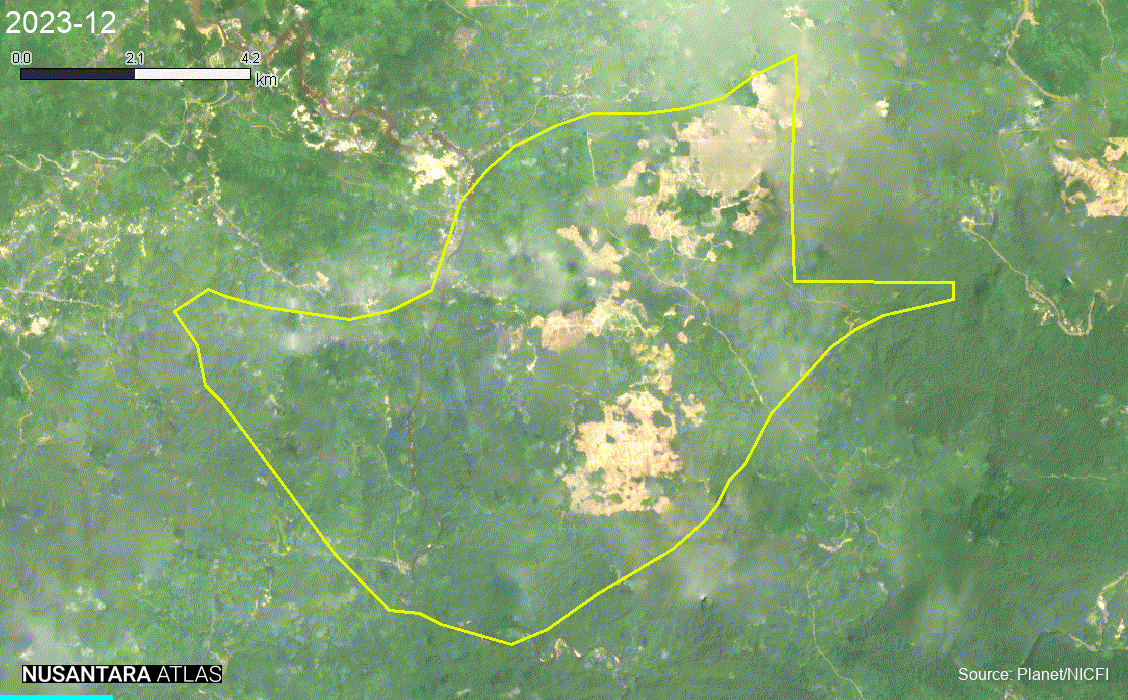
Table 1. List of companies converting old-growth/primary forest to industrial monoculture oil palm in 2024. This table only shows conversion >50 ha.
| No | Company Name | Group | Concession (Ha) | Province | Palm-oil Deforestation (Ha) | ||
| 1 | Inti Kebun Sawit | Ciliandry Anky Abadi | 13,344 | West Papua | 1,628 | ||
| 2 | Borneo International Anugerah | First Borneo | 20,016 | West Kalimantan | 1,465 | ||
| 3 | Banyan Tumbuh Lestari | Buana Pratama Cipta | 18,720 | Gorontalo | 1,438 | ||
| 4 | Inti Kebun Sejahtera | Ciliandry Anky Abadi | 21,885 | West Papua | 1,405 | ||
| 5 | Khatulistiwa Agro Abadi | First Borneo | 16,868 | West Kalimantan | 1,000 | ||
| 6 | Berkah Sawit Abadi | First Borneo | 34,000 | West Kalimantan | 898 | ||
| 7 | Uniseraya | Uniseraya | 8,692 | Riau | 644 | ||
| 8 | Setia Agro Abadi | Sulaidy | 18,118 | East Kalimantan | 607 | ||
| 9 | Kaltim Hijau Makmur | CT Agro | 15,157 | East Kalimantan | 576 | ||
| 10 | Tridaya Hutan Lestari | Ciliandry Anky Abadi | 9,588 | East Kalimantan | 500 | ||
| 11 | Kayan Plantation | Other/unknown | 15,105 | North Kalimantan | 497 | ||
| 12 | Putra Kurnia | Other/unknown | 1,783 | Aceh | 409 | ||
| 13 | Borneo Citra Persada Jaya | Sulaidy | 17,927 | East Kalimantan | 396 | ||
| 14 | Alam Lestari Indah | Other/unknown | 3,394 | Central Kalimantan | 324 | ||
| 15 | Kalimantan Ria Sejahtera | Tanoto family/DTK Opportunity | 12,335 | Central Kalimantan | 316 | ||
| 16 | Loka Indah Lestari | Other/unknown | 15,410 | Gorontalo | 289 | ||
| 17 | Arjuna Utama Sawit | Other/unknown | 15,651 | Central Kalimantan | 289 | ||
| 18 | Hardaya Inti Plantations | Central Cipta Murdaya (Murdaya Family) | 27,643 | Central Sulawesi | 259 | ||
| 19 | Karya Makmur Langgeng | Bumitama | 19,108 | West Kalimantan | 245 | ||
| 20 | Lahan Agro Inti Ketapang | Alam Indah Sdn Bhd/Meadows Capital Ltd | 12,472 | West Kalimantan | 220 | ||
| 21 | Dua Perkasa Lestari | Other/unknown | 2,591 | Aceh | 213 | ||
| 22 | Sumber Rahmat Sentosa | Other/unknown | 6,477 | Central Kalimantan | 198 | ||
| 23 | Menthobi Mitra Lestari (PT Menthobi Sawit) | Bakrie | 10,691 | Central Kalimantan | 190 | ||
| 24 | Surya Panen Subur | Rachmat/Amara | 14,865 | Aceh | 184 | ||
| 25 | Nia Yulided Bersaudara | Other/unknown | 2,179 | Aceh | 181 | ||
| 26 | Mitra Kapuas Agro | First Borneo | 7,229 | West Kalimantan | 181 | ||
| 27 | Permata Sawit Mandiri | Sepanjang | 16,770 | West Kalimantan | 171 | ||
| 28 | Wana Catur Jaya Utama | Rajawali/Eagle High | 11,387 | Central Kalimantan | 161 | ||
| 29 | Dongin Prabhawa | Korindo | 37,113 | Papua | 161 | ||
| 30 | Ruta Jona Lestari | Other/unknown | 20,729 | Central Kalimantan | 153 | ||
| 31 | Permata Nusa Mandiri | Salim/IndoGunta | 17,396 | Papua | 147 | ||
| 32 | Alam Sari Lestari | Other/unknown | 12,446 | Riau | 146 | ||
| 33 | Archipelago Timur Abadi | Agrindo | 15,059 | Central Kalimantan | 145 | ||
| 34 | USU | Asian Agri Group | 6,769 | North Sumatera | 141 | ||
| 35 | Mitra Sawit Makmur | Other/unknown | 7,119 | East Kalimantan | 134 | ||
| 36 | Anugerah Niaga Sawindo | Other/unknown | 7,982 | Riau | 134 | ||
| 37 | Palmdale Agroasia Makmur | Gozco Plantations | 16,983 | West Kalimantan | 123 | ||
| 38 | Sandai Makmur Sawit | Other/unknown | 10,084 | West Kalimantan | 122 | ||
| 39 | Bina Sarana Sawit Utama | Samuel | 26,340 | Central Kalimantan | 120 | ||
| 40 | Palm Beach Indonesia | Other/unknown | 14,419 | West Kalimantan | 100 | ||
| 41 | Krida Darma Kahuripan | Makin | 13,508 | Central Kalimantan | 98 | ||
| 42 | Bangun Batara Raya | DTK Opportunity | 2,578 | Central Kalimantan | 97 | ||
| 43 | Blang Ara | Other/unknown | 5,621 | Aceh | 90 | ||
| 44 | Citra Sawit Cemerlang | Genting | 14,353 | West Kalimantan | 79 | ||
| 45 | Mata Andau Sawit Kahuripan | Makin | 22,098 | Central Kalimantan | 79 | ||
| 46 | Sepalar Yasa Kartika | Other/unknown | 14,960 | Central Kalimantan | 74 | ||
| 47 | Katingan Hijau Lestari | Other/unknown | 9,526 | Central Kalimantan | 71 | ||
| 48 | Watu Gede Utama | Other/unknown | 6,015 | Aceh | 71 | ||
| 49 | Prasetya Mitra Muda (Block I) | Other/unknown | 7,493 | Central Kalimantan | 71 | ||
| 50 | Wahana Hamparan Hijau | First Borneo | 19,724 | West Kalimantan | 70 | ||
| 51 | Subur Karunia Raya | Salim/IndoGunta | 38,600 | West Papua | 66 | ||
| 52 | Laot Bangko | Other/unknown | 7,499 | Aceh | 66 | ||
| 53 | Sariwana Adi Perkasa | Goodhope | 9,725 | Papua | 65 | ||
| 54 | Borneo Citra Persada Abadi | Sulaidy | 14,303 | East Kalimantan | 65 | ||
| 55 | Bais Nusantara | Other/unknown | 9,758 | North Kalimantan | 64 | ||
| 56 | Kurun Sumber Rejeki | Other/unknown | 9,481 | Central Kalimantan | 59 | ||
| 57 | Mitra Karya Sentosa | Fangiono Family/First Resources | 22,415 | West Kalimantan | 57 | ||
| 58 | Swadaya Mukti Prakarsa | Fangiono Family/First Resources | 21,116 | West Kalimantan | 55 | ||
| 59 | Prasetya Mitra Muda (Block II) | Other/unknown | 2,468 | Central Kalimantan | 51 |
Table 2. List of companies converting peatlands to industrial monoculture oil palm in 2024. This table only shows conversion >50 ha.
| No | Company Name | Group | Concession (Ha) | Location | Clearing on peat (Ha) | ||
| 1 | Borneo International Anugerah | First Borneo | 20,016 | West Kalimantan | 1,497 | ||
| 2 | Uniseraya | Uniseraya | 8,692 | Riau | 1,434 | ||
| 3 | Samora Usaha Jaya | Sungai Budi/Tunas Baru Lampung | 17,560 | South Sumatera | 1,004 | ||
| 4 | Arjuna Utama Sawit | Other/unknown | 15,651 | Central Kalimantan | 418 | ||
| 5 | Surya Panen Subur | Rachmat/Amara | 14,865 | Aceh | 256 | ||
| 6 | Alam Sari Lestari | Other/unknown | 12,446 | Riau | 224 | ||
| 7 | Palmdale Agroasia Makmur | Gozco Plantations | 16,983 | West Kalimantan | 180 | ||
| 8 | Sumber Sawit Mitrajaya | Other/unknown | 15,111 | East Kalimantan | 108 | ||
| 9 | Bina Tani Sawit Sedulang | Other/unknown | 1,124 | East Kalimantan | 97 | ||
| 10 | Lahan Agro Inti Ketapang | Alam Indah Sdn Bhd/Meadows Capital Ltd | 12,472 | West Kalimantan | 93 | ||
| 11 | Palm Beach Indonesia | Other/unknown | 14,419 | West Kalimantan | 80 | ||
| 12 | Sumber Sawit Sejahtera | Other/unknown | 2,891 | Riau | 56 | ||
| 13 | Inti Kebun Sejahtera | Ciliandry Anky Abadi | 21,885 | West Papua | 56 | ||
| 14 | Sawit Jaya Makmur | Alas Kusuma | 15,393 | West Kalimantan | 48 | ||
| 15 | Borneo Sawit Perdana | Other/unknown | 10,814 | Central Kalimantan | 47 | ||
| 16 | Wana Subur Sawit Indah | Other/unknown | 5,699 | Riau | 45 | ||
| 17 | Surya Keritang Perkasa | Other/unknown | 2,022 | Riau | 39 | ||
| 18 | Pinang Witmas Abadi | Pinang Witmas Sejati | 10,548 | West Kalimantan | 35 | ||
| 19 | Mitra Andalan Sejahtera | Parna Raya | 13,025 | West Kalimantan | 31 | ||
| 20 | Ricky Kurniawan Kertapersada | Makin | 3,836 | Jambi | 29 | ||
| 21 | Tania Binatama | Sampoerna Agro | 5,108 | South Sumatera | 25 |
The TreeMap endeavours to protect tropical forests through scientific research and advanced monitoring platforms. We are cartographers, remote sensing engineers, AI Scientists, software developers, and field investigators. We empower civil society with the tools to detect deforestation in real-time and ensure what happens on the ground is fair, transparent, and democratic. We build systems that check the deforestation footprint of agribusinesses in tropical forests to ensure sustainable production. Our work is based on the premise that no one wants food and other products to be the cause of forest destruction.